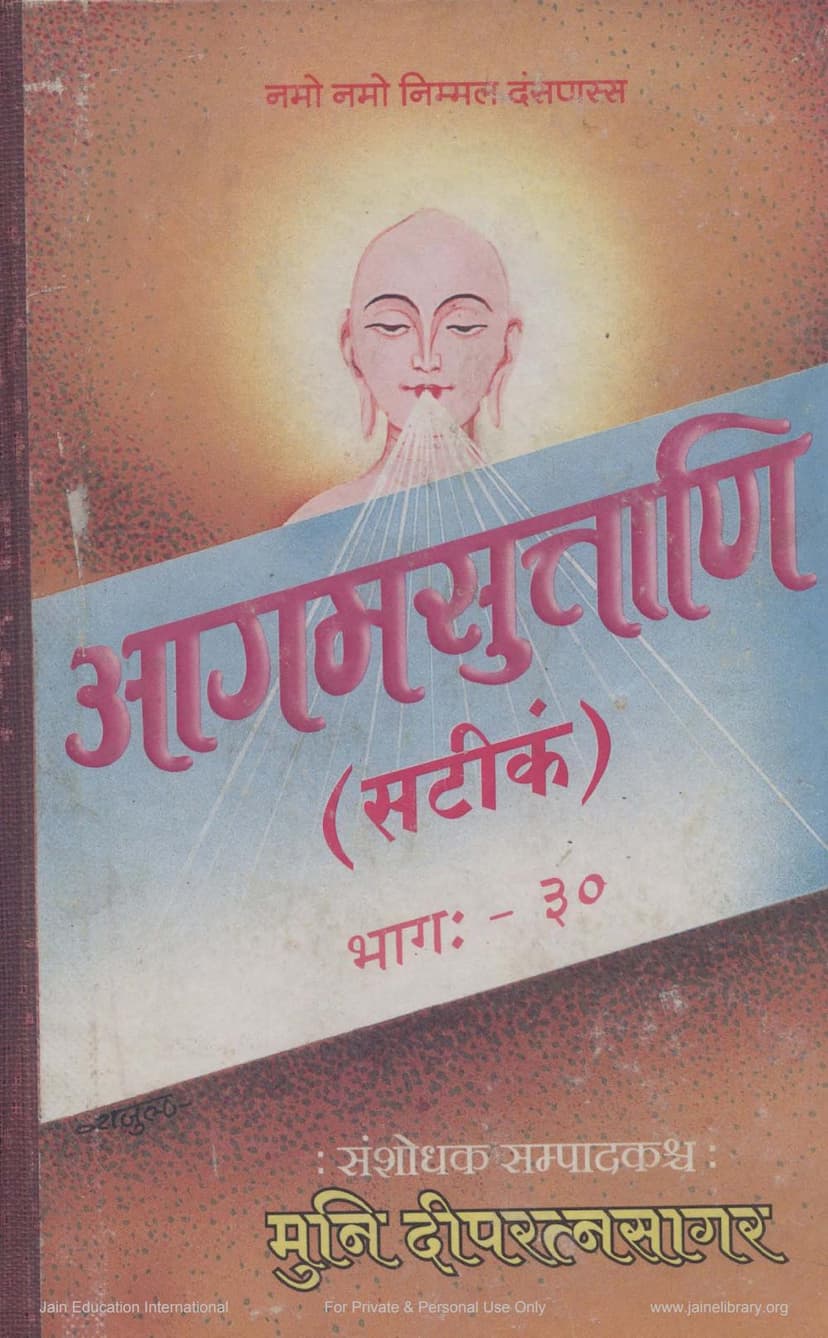Agam Suttani Satikam Part 30 Nandi Anuyoddwar
Added to library: September 1, 2025

Summary
The provided text is a section of the Jain Agam Sutra, specifically the third part of the Agam Suttani Satikam, titled "Nandi Anuyoddwar," volume 30. It was researched and edited by Muni Dipratnasagar. The text is a commentary on two important Jain scriptures: the Nandi Sutra and the Anuyogdwar Sutra.
Here's a breakdown of the content based on the provided pages:
Overall Structure:
- Book Title: Agam Suttani Satikam Part 30 Nandi Anuyoddwar
- Author(s): Dipratnasagar, Deepratnasagar (likely referring to the same individual or their lineage)
- Publisher: Agam Shrut Prakashan
- Content: The book contains the Nandi Sutra (44) and the Anuyogdwar Sutra (45), along with a commentary (Sateek) by Muni Dipratnasagar.
- Date: Compiled on April 14, 2000, Sunday, Chaitra Sud 11, 2056 Vikram Samvat.
- Purpose: Intended for private and personal use by JAIN EDUCATION INTERNATIONAL.
Key Sections and Themes:
- Veneration: The text begins with salutations and venerations to the Nirmal Darshan (pure vision), the Āgams (scriptures), Muni Dipratnasagar, and revered spiritual gurus.
- Nandi Sutra:
- Contents: Starts with invocations (Veerastuti, Sangha-stuti, Jinavandan, Gana-vandana, Jina-shasan-stuti), followed by the lineage of venerable monks (Sthaviravali). It also mentions the audience (Shrōta, Parishada) and delves into the categories of knowledge (Gyānāsya Bhedah).
- Specific Knowledge Types: It describes Avadhigyan (clairvoyance), Manah-paryavagyan (mind-reading knowledge), and Kevalgyan (omniscience), as well as Mati (sense-knowledge) and Shruta (scriptural knowledge). It also touches upon Anga-pravishtha Sutra.
- Anuyogdwar Sutra:
- Contents: This section focuses on knowledge (Gyān) and its various aspects, including Nīkṣepa (modes of existence/classification), types (Bhed), and the study of the Āvaśyaka (essential daily duties).
- Philosophical Concepts: It elaborates on Shruta (scriptural knowledge), Dravya (substance), Upakrama (methods of inquiry), Ānupūrvī (sequence), Anugama (inference), Naya (viewpoints), Pramana (means of valid knowledge), and the nature of the seven Nayas (viewpoints).
- Theological/Cosmological Elements: It mentions Vaktavyata (statement/exposition), Nīkṣepa (classification), and the Saptnaya Swarūpa (nature of seven viewpoints).
- Appendices: The table of contents also indicates "Anugyan Nandi - Appendix - 1" and "Yog Nandi - Appendix - 2," suggesting further supplementary material.
- Financial Support: Page 4 and 5 list numerous "Financial Contributors" (Ārthik Anudātā) who sponsored the printing and distribution of this book, often in honor of various revered monks and nuns. This highlights the collaborative effort behind such publications in Jainism.
Core Jain Principles Discussed:
The text appears to be a scholarly work delving into the epistemology and cosmology of Jainism, as presented in foundational texts like the Nandi and Anuyogdwar Sutras. Key concepts likely explored include:
- Knowledge (Gyān): The different types and states of knowledge are a central theme, particularly the progression from sensory perception (Mati) to omniscience (Kevalgyan).
- Substance (Dravya): The nature of reality and how it is understood through various categories.
- Naya (Viewpoints): The manifold ways of understanding reality, a crucial aspect of Jain logic.
- Karma and Liberation: While not explicitly detailed in the table of contents, the mention of "mokṣa-soukhya" (liberation bliss) suggests the ultimate goal of Jain practice, which is achieved through understanding and practice of Dharma, often detailed in these texts.
- Spiritual Hierarchy: The veneration of gurus and the mention of lineage (Sthaviravali) indicate the importance of the spiritual teacher-disciple tradition in Jainism.
- Daily Practices (Āvaśyaka): The mention of Āvaśyaka indicates the practical and devotional aspects of Jainism, which are considered essential duties.
In essence, this is a detailed and technical commentary on foundational Jain scriptures, aiming to explain complex philosophical and epistemological concepts within the Jain tradition. The inclusion of appendices and acknowledgments suggests a community effort in preserving and disseminating this knowledge.